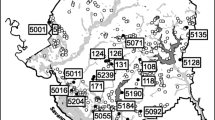Abstract
We examined standing crops and ecology of aquatic invertebrates in agricultural drainwater evaporation ponds in California from October 1982 to March 1983 and September 1983 to March 1984. Evaporation ponds supported low diversities but high standing crops of aquatic invertebrates. A water boatman (Trichocorixa reticulata) and a midge (Tanypus grodhausi) were the most abundant invertebrates, constituting 44.9% and 51.4% of total macroinvertebrate biomass. Regression models indicated that of 6 environmental variables measured, only electrical conductivity (EC) and Julian date affected biomass and density of water boatmen. EC was the only significant correlate of midge biomass in evaporation ponds.
Similar content being viewed by others
Literature Cited
Benke, A. C. 1984. Secondary production of aquatic insects. p. 289–322.In V. H. Resh and D. M. Rosenberg (eds.). The Ecology of Aquatic Insects. Praeger Publishers, New York, NY, USA.
Borror, D. J., D. M. DeLong, and C. A. Triplehom. 1981. An Introduction to the Study of Insects. Fifth edition. Saunders College Publishing, New York, NY, USA.
Coe, H. N. 1990. Use of wetlands in the Tulare Lake Basin by wintering ducks. M. S. Thesis. Oregon State University, Corvallis, OR, USA.
Connelly, D. P. and D. L. Chesemore. 1980. Food habits of pintails,Anas acuta, wintering on seasonally flooded wetlands in the northern San Joaquin Valley, California. California Fish and Game 66: 233–237.
Euliss, N. H., Jr. 1989. Assessment of drainwater evaporation ponds as waterfowl habitat in the San Joaquin Valley, California. Ph.D. Dissertation. Oregon State University, Corvallis, OR, USA.
Euliss, N. H., Jr. and S. W. Harris. 1987. Feeding ecology of northern pintails and green-winged teal wintering in California. Journal of Wildlife Management 51: 724–732.
Fujii, R. 1988. Water-quality and sediment-chemistry data of drain water and evaporation ponds from Tulare Lake Drainage District, Kings County, CA, March 1985–March 1986. United States Geological Survey Open-file report 87-700, Sacramento, CA, USA.
Grodhaus, G. 1967. Identification of chironomid midges commonly associated with waste stabilization lagoons in California. California Vector Views 14: 1–12.
Hanson, B. R. 1982. A master plan for drainage in the San Joaquin Valley. California Agriculture 36: 9–10.
Heitmeyer, M. E. 1988. Protein costs of the prebasic molt of female mallards. Condor 90: 263–266.
Howmiller, R. P. 1972. Effects of preservatives on weights of some common macrobenthic invertebrates. Transactions of the American Fisheries Society 101: 743–746.
Ives, J. H., G. R. Hazel, P. Gaffney, and A. W. Nelson. 1977. An evaluation of the feasibility of utilizing agricultural tile drain water for marsh management in the San Joaquin Valley, California. Jones and Stokes Associates, Incorporated, Sacramento, CA, USA.
Kahrl, W. L. (ed.). 1979. The California water atlas. Calif. Governor’s Office of Planning and Research. Los Altos, CA, USA.
Kimerle, R. A. and N. H. Anderson. 1971. Production and bioenergetic role of the midgeGlyptotendipes barbipes (Staeger) in a waste stabilization lagoon. Limnology and Oceanography 16: 646–659.
Krapu, G. L. 1979. Nutrition of female dabbling ducks during reproduction. p. 59–70.In T. A. Bookhout (ed.) Waterfowl and wetlands — an integrated review. Proceedings of the 1977 Symposium, Northcentral Section, The Wildlife Society, Madison, WI, USA.
Krapu, G. L. 1981. The role of nutrient reserves in mallard reproduction. Auk 98: 29–38.
Krapu, G. L. and G. A. Swanson. 1975. Some nutritional aspects of reproduction in prairie nesting pintails. Journal of Wildlife Management 39: 156–162.
Lindegaard, C. and P. M. Jonasson. 1979. Abundance, population dynamics and production of zoobenthos in Lake Myvatn, Iceland. Oikos 32: 202–227.
Maitland, P. S. and P. M. G. Hudspith. 1974. The zoobenthos of Loch Leven, Kinross, and estimates of its production in the sandy littoral area during 1970 and 1971. Proceedings of the Royal Society of Edinberg 74: 219–239.
Merritt, R. W. and K. W. Cummins. 1984. An Introduction to the Aquatic Insects of North America. Second edition. Kendall-Hunt Publishing Company, Dubuque, IA, USA.
Miller, M. R. 1987. Fall and winter foods of northern pintails on three northern California refuges. Journal of Wildlife Management 51: 403–412.
Milliken, G. A. and D. E. Johnson. 1984. Analysis of Messy Data, Volume 1: Designed Experiments. Van Nostrand Reinhold Company, New York, NY, USA.
Morgan, N. C., T. Backiel, G. Bretschko, A. Duncan, A. Hillbricht-Ilkowske, Z. Kajak, J. F. Kitchell, P. Larsson, C. Leveque, A. Nauwerck, F. Schiemer, and J. E. Thorpe. 1980. Secondary production. p. 247–340.In E. D. LeCren and R. H. Lowe-McConnell (eds.) The Functioning of Freshwater Ecosystems. Cambridge University Press, Cambridge, England.
Presser, T. S. and I. Barnes. 1985. Dissolved constituents including selenium in water in the vicinity of Kesterson National Wildlife Refuge and West Grasslands, Fresno and Merced Counties, California. United States Geological Survey, Water Research Investigations Report 85-4220, Menlo Park, CA, USA.
SAS Institute, Inc. 1985. SAS/STAT guide for personal computers, Version 6. Cary, NC, USA.
Snedecor, G. W. and W. G. Cochran. 1980. Statistical Methods. Seventh edition. Iowa State University Press, Ames, IA, USA.
Swanson, G. A. 1977. Self-cleaning screen for processing benthic samples. Progressive Fish Culturist 39: 177–178.
Swanson, G. A. 1978a. A simple lightweight core sampler for quantitating waterfowl foods. Journal of Wildlife Management 42: 426–428.
Swanson, G. A. 1978b. A water column sampler for invertebrates in shallow wetlands. Journal of Wildlife Management 42: 670–671.
Tiner, R. W., Jr. 1984. Wetlands of the United States: current status and recent trends. Government Printing Office, Washington, DC, USA.
United States Fish and Wildlife Service. 1961. Master development plan: Kern National Wildlife Refuge. United States Fish and Wildlife Service, Portland, OR, USA.
Usinger, R. L. 1956. Aquatic Insects of California, University of California Press, Berkeley, CA, USA.
Ward, H. B. and G. C. Whipple. 1959. Fresh-water Biology. Second edition. John Wiley and Sons, New York, NY, USA.
Author information
Authors and Affiliations
Rights and permissions
About this article
Cite this article
Euliss, N.H., Jarvis, R.L. & Gilmer, D.S. Standing crops and ecology of aquatic invertebrates in agricultural drainwater ponds in California. Wetlands 11, 179–190 (1991). https://doi.org/10.1007/BF03160848
Received:
Revised:
Accepted:
Issue Date:
DOI: https://doi.org/10.1007/BF03160848




